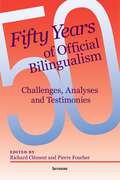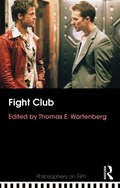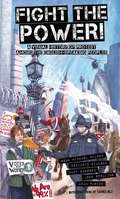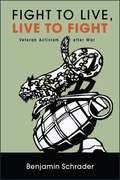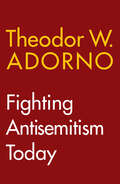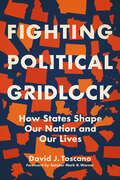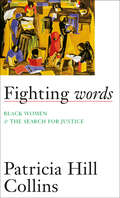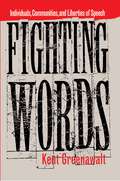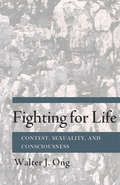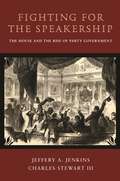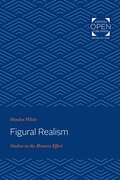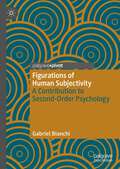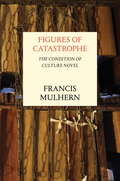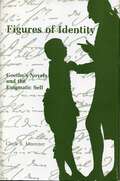- Table View
- List View
Fifty Years of Official Bilingualism: Challenges, Analyses and Testimonies
by Richard ClémentFifty years ago, the Royal Commission on Bilingualism and Biculturalism published its final report. The result of innovative research and public consultations across the country, this report, replete with data and concepts, sets the stage for a comprehensive policy on official bilingualism, which would profoundly and indelibly change the face of Canada. The resolve to affirm the officially bilingual character of the country was met with the equally fervent determination to make French the common language of Quebecers. This book provides a critical view of the content and the consequences of the report. It is the outcome of a series of conferences held across the country in 2013, which explored the impact of these two aspects. It combines analyses of the Commission's activities, its main players, and the specific content of certain volumes of the report. The book is divided into three parts: the first outlines the progress accomplished since the publication of the report and contributors' views of the challenges which continue to create controversy; the second part provides analyses and studies of topics covered by the Commission, effectively demonstrating how far things have evolved; and the third features testimonials, including a fascinating conversation between the first Commissioner for Official Languages, Keith Spicer, and the Commissioner in office at the time of publication, Graham Fraser.
Fifty Years of Women in Mathematics: Reminiscences, History, and Visions for the Future of AWM (Association for Women in Mathematics Series #28)
by Cathy Kessel Janet L. Beery Sarah J. GreenwaldThe Assocation for Women in Mathematics (AWM), the oldest organization in the world for women in mathematics, had its fiftieth anniversary in 2021. This collection of refereed articles, illustrated by color photographs, reflects on women in mathematics and the organization as a whole. Some articles focus on the situation for women in mathematics at various times and places, including other countries. Others describe how individuals have shaped AWM, and, in turn, how the organization has impacted individuals as well as the broader mathematical community. Some are personal stories about careers in mathematics. Fifty Years of Women in Mathematics: Reminiscences, History, and Visions for the Future of AWM covers a span from AWM’s beginnings through the following fifty years. The volume celebrates AWM and its successes but does not shy away from its challenges.The book is designed for a general audience. It provides interesting and informative reading for people interested in mathematics, gender equity, or organizational structures; teachers of mathematics; students at the high school, college, and graduate levels; and members of more recently established organizations for women in mathematics and related fields or prospective founders of such organizations.
Fight Club (Philosophers on Film)
by Thomas E. WartenbergReleased in 1999, Fight Club is David Fincher’s popular adaption of Chuck Palahniuk’s cult novel, and one of the most philosophically rich films of recent years. This is the first book to explore the varied philosophical aspects of the film. Beginning with an introduction by the editor that places the film and essays in context, each chapter explores a central theme of Fight Club from a philosophical perspective. Topics discussed include: Fight Club, Plato’s cave and Descartes’ cogito moral disintegration identity, gender and masculinity visuals and narration. Including annotated further reading at the end of each chapter, Fight Club is essential reading for anyone interested in the film, as well as those studying philosophy and film studies.
Fight the Power!
by Sean Michael Wilson Polyp Benjamin Dickson Hunt Emerson Adam PasionThis book visualises key moments in history where ordinary people have risen up and fought governments, corporations, even empires. When the 99% have stood up to combat exploitation and abuse or in pursuit of freedom of action and a better life. In other words, to show times in history, when people have struggled forward to FIGHT THE POWER!
Fight to Live, Live to Fight: Veteran Activism after War (SUNY series in New Political Science)
by Benjamin SchraderWhile veterans are often cast as a "problem" for society, Fight to Live, Live to Fight challenges this view by focusing on the progressive, positive, and productive activism that veterans engage in. Benjamin Schrader weaves his own experiences as a former member of the American military and then as a member of the activist community with the stories of other veteran activists he has encountered across the United States. An accessible blend of political theory, international relations, and American politics, this book critically examines US foreign and domestic policy through the narratives of post-9/11 military veterans who have turned to activism after having exited the military. Veterans are involved in a wide array of activism, including but not limited to antiwar, economic justice, sexual violence prevention, immigration issues, and veteran healing through art. This is an accessible, captivating, and engaging work that may be read and appreciated not just by scholars, but also students and the wider public.
Fighting Antisemitism Today: A Lecture
by Theodor W. AdornoIn autumn 1962 Theodor W. Adorno gave a lecture on fighting antisemitism to the German Coordinating Council of Societies for Christian-Jewish Cooperation, a lecture that remains as topical and urgent today as it was in the 1960s. After the Second World War, Germany was grappling with a reluctance to admit collective guilt for the horrors of the Holocaust and German society was witnessing the emergence of various forms of hidden or ‘crypto’ antisemitism. In his lecture Adorno demonstrated that antisemitism is a central and essential element of right-wing extremism and is identical in structure to racism. It is accompanied by an authoritarian mindset and a conformist anti-intellectualism. Moreover, a classic trick used by anti-Semites is to protest against taboos which prevent them from freely spreading their hate by classing them as a form of persecution, and to present themselves as victims of it. The only antidote to this poison is an unwavering loyalty to the truth in dealing with historical and political realities. Adorno advocates an anti-authoritarian programme to prevent antisemitic character development and advises taking firm action against outbreaks of antisemitic behaviour. His brilliant analysis of the sources and dangers of antisemitism is as relevant now as it was sixty years ago.
Fighting Back in Appalachia: Traditions of Resistance and Change
by Stephen L. FisherEssays explore various forms of resistance in Appalachia including community organizing and labor unions.
Fighting God: An Atheist Manifesto for a Religious World
by David SilvermanFighting God is a firebrand manifesto from one of the most recognizable faces of atheism. In his book, Silverman-a walking, talking atheist billboard known for his appearances on Fox News-discusses the effectiveness, ethics and impact of the in-your-face-atheist who refuses to be silent.Silverman argues that religion is more than just wrong: it is malevolent and does not deserve our respect. It is our duty to be outspoken and do what we can to bring religion down. Examining the mentality, methods and issues facing the firebrand atheist, Silverman presents an overwhelming argument for firebrand atheism and reveals:- All religion is cafeteria religion and almost all agnostics are atheists.- American society grants religion a privileged status, despite the intentions of the Founding Fathers.- Christian politicians have adversely (and un-Constitutionally) affected our society with regard to science, health, women's rights, and gay rights.- The notion of "atheist Jews" is a lie forced on us by religion.- It is not "Islamophobia" to observe dangerous teachings and disproportionate violence in Islam.- Atheists are slowly but surely winning the battle.Fighting God is a provocative, unapologetic book that takes religion to task and will give inspiration to non-believers and serve as the ultimate answer to apologists.
Fighting Political Gridlock: How States Shape Our Nation and Our Lives
by David J. ToscanoIn this profoundly polarized era, the nation has been transfixed on the politics of Washington and its seemingly impenetrable gridlock. Many of the decisions that truly affect people’s lives, however, are being made not on the federal level but in the states. Faced with Washington’s political standoff, state governments are taking action on numerous vital issues, often impacting citizens and their communities far more than the decision makers in D.C. Despite this, few Americans really understand their state governments or the issues they address. In Fighting Political Gridlock, David Toscano reveals how the states are working around the impasse in Washington and how their work is increasingly shaping society.Long a central figure in one of the most important legislative bodies in the nation, the Virginia House of Delegates, Toscano brings a unique expertise to this urgent and timely discussion. Beginning with an analysis of state responses to COVID-19, including the processes and consequences of declaring states of emergency, he goes on to detail how various states are attacking issues in different ways–from education and voting to criminal justice and climate change–and provides a broad overview of how state actions affect our system of federalism. Toscano concludes with a call to action and civic engagement, including suggestions for how citizens and public officials can revitalize American democracy.
Fighting Scholars: Habitus and Ethnographies of Martial Arts and Combat Sports (Key Issues In Modern Sociology Ser.)
by Dale C. Spencer Raul Sanchez GarciaFighting Scholars brings to the fore the ethnographic study of combat sports and martial arts as a means of exploring embodied human existence. The book's main claim is that such activities represent privileged grounds to access different social dimensions, such as emotion, violence, pain, gender, ethnicity and religion. To explore these dimensions, the concept of 'habitus' is presented prominently as an epistemic remedy for the academic distant gaze of the effaced academic body. The different contributions of this volume are aligned within the same project that began to crystallize in Loïc Wacquant's 'Body and Soul': the construction of a 'carnal sociology' that constitutes an exploration of the social world 'from' the body. The book is divided into three sections. In the first section, the editors introduce the field, providing a typology of existing literature. The second section contains the contributions of the authors, discussing their respective approaches to embodied ethnography, their use of the concept of 'habitus', and ethnographic findings. The third section contains a conclusion by the editors - reflecting on existing conceptions of 'habitus' and interdisciplinary possibilities for rethinking the concept - and an epilogue by Loïc Wacquant critically assessing the whole volume.
Fighting Songs and Warring Words: Popular Lyrics of Two World Wars
by Brian MurdochFirst published in 1990. Routledge is an imprint of Taylor & Francis, an informa company.
Fighting Words: Black Women And The Search For Justice (Contradictions Of Modernity Series #Volume Seven)
by Patricia Hill CollinsA professor of sociology explores how black feminist thought confronts the injustices of poverty and white supremacy, and argues that those operating outside the mainstream emphasize sociological themes based on assumptions different than those commonly accepted.
Fighting Words: Individuals, Communities, and Liberties of Speech
by Kent GreenawaltShould "hate speech" be made a criminal offense, or does the First Amendment oblige Americans to permit the use of epithets directed against a person's race, religion, ethnic origin, gender, or sexual preference? Does a campus speech code enhance or degrade democratic values? When the American flag is burned in protest, what rights of free speech are involved? In a lucid and balanced analysis of contemporary court cases dealing with these problems, as well as those of obscenity and workplace harassment, acclaimed First Amendment scholar Kent Greenawalt now addresses a broad general audience of readers interested in the most current free speech issues.
Fighting for Life: Contest, Sexuality, and Consciousness
by Walter J. OngWhat accounts for the continued popularity of the macho image, the fanaticism of sports enthusiasts, the perennial appeal of Don Quixote's ineffectual struggles? Walter J. Ong addresses these and related questions as he offers new insights into the complex ways in which human life is affected by contest. Ong argues that the struggle for dominance, which he feels is crucial among higher animal species, is more immediately critical for males than for females, helping males to manage persistent insecurity and to establish sexual identity. The male agonistic drive finds an outlet in contests as diverse as football, cockfighting, and chess--the last, the ultimate intellectualization of formalized territorial combat. Demonstrating the importance of contest in biological evolution and in the growth of consciousness out of the unconscious, Ong shows how adversarial today's shifting patterns of contest in such arenas as spectator sports, politics, business, religion, academe, and the history of rhetoric. Human internalization of agonistic drives, he concludes, can foster the deeper discovery of the self and of distinctively human freedom.
Fighting for the Speakership: The House and the Rise of Party Government (Princeton Studies in American Politics: Historical, International, and Comparative Perspectives #131)
by Jeffery A. Jenkins Charles StewartThe Speaker of the House of Representatives is the most powerful partisan figure in the contemporary U.S. Congress. How this came to be, and how the majority party in the House has made control of the speakership a routine matter, is far from straightforward. Fighting for the Speakership provides a comprehensive history of how Speakers have been elected in the U.S. House since 1789, arguing that the organizational politics of these elections were critical to the construction of mass political parties in America and laid the groundwork for the role they play in setting the agenda of Congress today. Jeffery Jenkins and Charles Stewart show how the speakership began as a relatively weak office, and how votes for Speaker prior to the Civil War often favored regional interests over party loyalty. While struggle, contention, and deadlock over House organization were common in the antebellum era, such instability vanished with the outbreak of war, as the majority party became an "organizational cartel" capable of controlling with certainty the selection of the Speaker and other key House officers. This organizational cartel has survived Gilded Age partisan strife, Progressive Era challenge, and conservative coalition politics to guide speakership elections through the present day. Fighting for the Speakership reveals how struggles over House organization prior to the Civil War were among the most consequential turning points in American political history.
Figural Realism: Studies in the Mimesis Effect
by Hayden WhiteOriginally published in 1998. In his earlier books such as Tropics of Discourse and The Content of the Form, Hayden White focused on the conventions of historical writing and on the ordering of historical consciousness. In Figural Realism, White collects eight interrelated essays primarily concerned with the treatment of history in recent literary critical discourse. "'History' is not only an object we can study," writes White, "it is also and even primarily a certain kind of relationship to 'the past' mediated by a distinctive kind of written discourse. It is because historical discourse is actualized in its culturally significant form as a specific kind of writing that we may consider the relevance of literary theory to both the theory and the practice of historiography."
Figurationen des Mangels in Ästhetik, Design- und Kunstpraktiken (Ästhetiken X.0 – Zeitgenössische Konturen ästhetischen Denkens)
by Oliver Ruf Luca ViglialoroDas Konzept ‚Mängelwesen‘ hat seine vielleicht bekannteste Formulierung auf dem Feld der Geisteswissenschaften durch die philosophische Reflexion von Arnold Gehlen gefunden. In seinem Buch Der Mensch. Seine Natur und seine Stellung in der Welt (1940) entwirft er die nicht unumstrittene These, dass der Mensch ein solches ‚Mängelwesen‘ sei, da er weder somatisch noch auf dem Feld der Instinkte eine adäquate Anpassung an die Welt aufweisen könne. Im Vergleich zu anderen Lebensformen und Spezies sei er zudem arm an Mitteln zur Befriedigung sinnlicher Bedürfnisse. Dies führt nach Gehlen dazu, dass der Mensch situativ stetig interagieren muss und somit seine Zwecksetzungen gestalterisch einholt, um die eigene perzeptive und instinktive Mangelhaftigkeit zu kompensieren und Erfahrungsmöglichkeiten zu modellieren bzw. ggf. erhöhen. Der grundlegend anthropologische Diskurs zur Mangelhaftigkeit scheint deshalb konstitutiv mit Formen – im Sinne von Konzepten, Praktiken und nicht zuletzt Kulturtechniken – des Gestaltens zusammenzuhängen, die sich historisch konkretisieren. Der Band Figurationen des Mangels in Ästhetik, Design- und Kunstpraktiken geht dieser Erkundung von singulären Entwürfen und theoretisch-historischen Konstellationen nach, den Erscheinungen der Mangelhaftigkeit und des gestalterischen Umgangs mit ihren medialen und sinnlich-somatischen Ausformungen. Dabei werden nicht allein traditionelle Konzepte und Denkfiguren der Philosophie wie etwa jene des Supplements, der Prothese oder der Entlastung neu analysiert, sondern auch zeitgenössische medienästhetische und designtheoretische Ansätze. In dieser Hinsicht werden gestalterische Erprobungen (auf dem Gebiet sowohl der Kunst wie des Designs) sowie Körper- und Medienkonfigurationen, die sich durch spezifische Praktiken ereignen, als Problemfelder eines Diskurses des ‚Mängelwesens‘ betrachtet.
Figurationen spätmoderner Lebensführung (Adoleszenzforschung #10)
by Susanne Benzel Julia Schreiber Benedikt Salfeld Katarina BuschDer Band versammelt Beiträge, die sich dem Konnex von Psyche und Gesellschaft widmen, wie er auch im Zentrum der Arbeiten von Benigna Gerisch und Vera King steht. Anhand unterschiedlicher Themen wie Adoleszenz, Migration, Alter, Geschlecht und Generationenverhältnisse werden verschiedene Dimensionen spätmoderner Lebensführung beleuchtet. Übergreifend wird so der Frage nachgegangen, wie das Ineinandergreifen von psychischen und sozialen Dynamiken untersucht und verstanden werden kann.
Figurations of Human Subjectivity: A Contribution to Second-Order Psychology
by Gabriel BianchiThis book takes an empirically grounded perspective on research in values, intimacy and sexuality, among other topics in psychology, to highlight the importance of searching for human subjectivity in its diversity, plurality and self-generativity. The author conducts an in-depth discussion on the methodological and epistemological issues enabling the study of subjectivity, and argues that in order to improve the contribution of psychology to human knowledge, a study of subjectivity must be at the forefront.This book presents a critical reflection of the author’s decades-long research within psychology to argue for a significant paradigm shift in the conception and execution of psychological research: a shift to “second order psychology”.
Figures of Catastrophe
by Francis MulhernA bold new vision of the modern English novelThe leading critic Francis Mulhern uncovers a hidden history in the fiction of the past century, identifying a central new genre: the condition of culture novel. Reading across and against the grain of received patterns of literary association, tracing a line from Hardy and Forster, through Woolf, Waugh and Bowen, to Barstow, Fowles, Rendell, Naipaul, Amis, Kureishi and Smith, he elucidates the recurring topics and narrative logics of the genre, showing how culture emerges as a special ground of social conflict, above all between classes. The narrative evaluations of culture's ends--the aspirations and the destinies of those whose lives are the subject of these novels--grow steadily darker over time, and the writing itself grows more introverted.A concluding discussion elicits the characteristics of the English condition of culture novel, in an international setting, and closes in, finally, on the central conundrum of the genre: its uncanny reprise, in its own plane, of the historical arc of the modern labour movement in Britain, from its beginnings in the late nineteenth century through its post-war heyday to the seemingly inexorable decline of recent decades.From the Hardcover edition.
Figures of Identity: Goethe’s Novels and the Enigmatic Self (G - Reference, Information and Interdisciplinary Subjects)
by Clark S. MuenzerThe question of coherence in Goethe's novels, which, like Faust, compelled his attention throughout his creative life, has only recently occupied a few critics. Professor Muenzer's study offers the most comprehensive effort of this kind by examining the problematic nature of self-definition through the four novels and its emergence as a discursive process of the imagination.The self of these texts, Muenzer suggests, evolves as a symbolic construct that records a patter of pursuit for each of their protagonists and orients the reader toward three basic goals of human aspiration. Thus, Werther aspires to purposefulness as a center of teleological fulfillment, while the hero of Wilhelm Meister's Apprenticeship refers to an ideological center of participation in his social desire. Eduard, in The Elective Affinities, presumes to occupy a center of archaeological power through his typically self-assertive strategies.In the last of his novels, Wilhelm Meister's Journeymanship, Goethe articulates the need to balance all such self-involved behavior with an attitude of self-denial. Apparently, the mind can orient itself through centers of purpose, order, and power, but it must also recognize the illusion of their attainment. Identity does not involve a substantive presence, and the result of self-definition for Goethe is interpretive work.Each of Professor Muenzer's interpretations has been guided by this premise. The interests of all of Goethe's novelistic protagonists, he concludes, "serve as orienting postures toward goals that cannot be literally achieved." Consequently, symbolic resolutions are proposed. These then introduce new problems as points of departure in subsequent works. The hidden agenda of Goethe's work as a novelist is a self that exists as a textual problem, a series of interpretive moves that endlessly defer the attainment of self presence by supplementing each other in narrative fictions.
Figures of Simplicity: Sensation and Thinking in Kleist and Melville (SUNY series, Intersections: Philosophy and Critical Theory)
by Birgit M. KaiserFigures of Simplicity explores a unique constellation of figures from philosophy and literature—Heinrich von Kleist, Herman Melville, G. W. Leibniz, and Alexander Baumgarten—in an attempt to recover alternative conceptions of aesthetics and dimensions of thinking lost in the disciplinary narration of aesthetics after Kant. This is done primarily by tracing a variety of "simpletons" that populate the writings of Kleist and Melville. These figures are not entirely ignorant, or stupid, but simple. Their simplicity is a way of thinking; one that author Birgit Mara Kaiser here suggests is affective thinking. Kaiser avers that Kleist and Melville are experimenting in their texts with an affective mode of thinking, and thereby continue, she argues, a key line within eighteenth-century aesthetics: the relation of rationality and sensibility. Through her analyses, she offers an outline of what thinking can look like if we take affectivity into account.
Figures of Speech: First Amendment Heroes and Villains
by William TurnerRecounting controversial First Amendment cases from the Red Scare era to Citizens United, William Bennett Turner—a Berkeley law professor who has argued three cases before the Supreme Court—shows how we’ve arrived at our contemporary understanding of free speech. His strange cast of heroes and villains, some drawn from cases he has litigated, includes Communists, Jehovah’s Witnesses, Ku Klux Klansmen, the world’s leading pornographer, prison wardens, dogged reporters, federal judges, a computer whiz, and a countercultural comedian. This is a fascinating look at how the scope of our First Amendment freedoms has evolved and the colorful characters behind some of the most important legal decisions of modern times. “Turner tells fascinating stories of unlikely heroes and explains difficult legal issues clearly and concisely, educating and entertaining at the same time.”—Elizabeth Farnsworth, The PBS News Hour
Figures of Thought: Mathematics and Mathematical Texts
by David ReedRarely has the history or philosophy of mathematics been written about by mathematicians, and the analysis of mathematical texts themselves has been an area almost entirely unexplored. Figures of Thought looks at ways in which mathematical works can be read as texts, examines their textual strategies and demonstrates that such readings provide a rich source of philosophical issues regarding mathematics: issues which traditional approaches to the history and philosophy of mathematics have neglected. David Reed, a professional mathematician himself, offers the first sustained and critical attempt to find a consistent argument or narrative thread in mathematical texts. In doing so he develops new and fascinating interpretations of mathematicians' work throughout history, from an in-depth analysis of Euclid's Elements, to the mathematics of Descartes and right up to the work of contemporary mathematicians such as Grothendeick. He also traces the implications of this approach to the understanding of the history and development of mathematics.
Figurierte Zahlen: Veranschaulichung als heuristische Strategie
by Jochen ZiegenbalgDieses Buch behandelt die Visualisierung als Methode des mathematischen Problemlösens, Begründens und Beweisens: Konkrete Beispiele zur Veranschaulichung durch mathematische Figuren und Bilder bieten einen faszinierenden Einblick in das Argumentieren anhand strukturierter und strukturierender Figuren zur Betrachtung von Zahlen und Zahlenfolgen. Die historischen Wurzeln dieses mathematischen Handwerkszeugs werden dabei so weit wie möglich einbezogen. Die Beispiele sind in der Regel konstruktiver Natur; gelegentlich wird, wo angebracht, die algorithmische Erschließung durch Hinweise auf die Programmierung mit Hilfe von Computeralgebra Systemen ergänzt. Das Buch richtet sich an Studierende und Lehrende an Schulen und Hochschulen, sowie an alle an der Elementarmathematik interessierten Nichtspezialisten, die das mathematische Arbeiten einmal außerhalb der von den Bildungsinstitutionen vorgezeichneten Pfade kennenlernen wollen. Es liefert insbesondere Lehrkräften und Lehramtsstudierenden wertvolle Anregungen, etwa zur Förderung mathematisch interessierter Schülerinnen und Schüler. In der 2. Auflage ist mit den mathematisch fundamentalen und historisch bedeutsamen Themen Wechselwegnahme, Teilbarkeit, Euklidischer Algorithmus, Inkommensurabilität und Kettenbrüche ein neues, für Visualisierungen gut geeignetes Kapitel hinzugekommen. Bereits bestehende Kapitel wurde durch Abschnitte über Trapezzahlen, ungerade Quadratzahlen und zentrierte Polygonalzahlen ergänzt.
